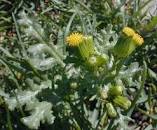March to April
The high season of Spring Weeds is here! Wondering what the names are of the weeds in the Garden this Spring?
Purple or Red Deadnettle (Lamium purpureum) of the mint family
 is flowering in many of the beds. On the positive side for this weed,
its little lavender flowers are an important source of food for bees now
when not many other flowers are available. For the intrepid, explore
its edible qualities at Eating Green -- harvest the young leaf shoots in the Spring and use within salads or smoothies or use as a tea.
is flowering in many of the beds. On the positive side for this weed,
its little lavender flowers are an important source of food for bees now
when not many other flowers are available. For the intrepid, explore
its edible qualities at Eating Green -- harvest the young leaf shoots in the Spring and use within salads or smoothies or use as a tea. This weed easily reproduces from seed or pieces of plant. Chopping it up & digging it into the soil can increase the number of plants. Pull it roots & all to better rid your plot of this weedy 'groundcover'.
Hairy Bittercress (Cardamine hirsuta) is another weed that is blooming and seeding up right now. It's a very invasive weed and the tiny seeds can be expelled several yards from the pod at maturity. Its delicate little white cluster of flowers sit tall on erect stems above the base of its leaves. This member of the mustard family is edible as a bitter herb.
⚠This is definitely not an edible weed, as chronic exposure can cause irreversible liver damage.
Galinsoga or Gallant Soldier
 |
| Galinsoga Seedling |
(Galinsoga parviflora and G. ciliata) known also as Quickweed, are easily pulled when young. You start seeing this subtropical annual in spring. It produces multiple generations (as many as 7500 seeds per plant per year), hence we see it galloping through the Garden in September and October before first frost if we are not vigilant in the Spring.
Do not compost this particular weed. The small white flowers you see produce many seeds which mature almost immediately – a great survival strategy for this little weed that has shallow roots and no rhizomes or reproduction by cuttings. Dispose of it in the vegetative pile out front for the DPW to pick up. Correspondingly, before using your weeding tools elsewhere, clean off the soil as their tiny seeds can be present in it.
 | ||
Galinsoga Gone to Seed
|
On the positive side, their presence indicates adequate to high nitrogen in the soil. And although considered by us a weed, other parts of the world use it culinarily and medicinally. Their young greens & stems are high in minerals and can be cooked and eaten.
See Galinsoga – Love It or Hate It for more info on its nutrition and uses. For more on this weed and other "Weeds of the Month" visit the July 22, 2016 Brooklyn Botanic Garden's Weed of the Month: Galinsoga. For strategies on controlling, it visit the University of Vermont's Galinsoga Management.
This weed, galinsoga, is known as guascas in Columbian cuisine. A lot of folk online are asking where they can get seeds to grow this herb! If you are adventuresome, you may want to make the special soup, Ajiaco Bogotano. If you have a friend from Columbia you may even persuade them to 'harvest' your weed and take it back to their kitchen along with you! It only takes 5 hrs to cook this soup so many rave about.








No comments:
Post a Comment